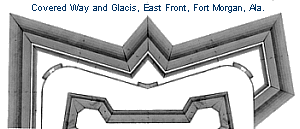Sometimes referred to as the Covert Way.
 In
field fortifications covered ways were routes of passage or roads sheltered
from enemy fire by sinking the road surface in a trench and protecting the
engaged side of the trench with a parapet. The profile of covered ways was
generally very similar to the first parallel in siege works or simple unrevetted
rifle trenches with the trench excavated wide enough for free circulation
of troops and the passage of wagons or artillery. Covered ways were generally
employed to connect two or more works through ground exposed to enemy fire. In
field fortifications covered ways were routes of passage or roads sheltered
from enemy fire by sinking the road surface in a trench and protecting the
engaged side of the trench with a parapet. The profile of covered ways was
generally very similar to the first parallel in siege works or simple unrevetted
rifle trenches with the trench excavated wide enough for free circulation
of troops and the passage of wagons or artillery. Covered ways were generally
employed to connect two or more works through ground exposed to enemy fire.
 In
permanent fortifications covered ways were outworks that ran parallel to
the crest of the counterscarp which allowed the garrison to guard and defend
the glacis and provided an open area exterior to the enceinte where troops
could be massed for a sortie or rallied after a sortie. The covered way was
immediately in rear of the glacis and generally 7 to 8 feet below the crest
of the glacis. In Vauban's First Method the covered way was about 10 yards
wide; its width being limited in an attempt to make it difficult for attacking
an enemy to establish an effective lodgment along the crest of the counterscarp. In
permanent fortifications covered ways were outworks that ran parallel to
the crest of the counterscarp which allowed the garrison to guard and defend
the glacis and provided an open area exterior to the enceinte where troops
could be massed for a sortie or rallied after a sortie. The covered way was
immediately in rear of the glacis and generally 7 to 8 feet below the crest
of the glacis. In Vauban's First Method the covered way was about 10 yards
wide; its width being limited in an attempt to make it difficult for attacking
an enemy to establish an effective lodgment along the crest of the counterscarp.
 In most systems the covered way was protected from enfilade
fire by a series of lateral traverses that broke the continuity of the covered
way and provided reduits for a protracted defense of the covered way after
an enemy had crowned the glacis and gained command over advanced sections
of the covered way. Both salient and re-entering places of arms were elements
of the covered way. In most systems the covered way was protected from enfilade
fire by a series of lateral traverses that broke the continuity of the covered
way and provided reduits for a protracted defense of the covered way after
an enemy had crowned the glacis and gained command over advanced sections
of the covered way. Both salient and re-entering places of arms were elements
of the covered way. |